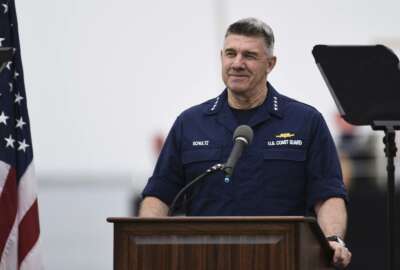
Coast Guard needs more money to address aging fleets, readiness
The Coast Guard needs more money to address aging fleets and fill capability gaps.
What would you do with an extra $1 billion? To a person, that kind of money would be life-changing, but it’s not exactly chump change for a federal agency either. When Rep. Sean Maloney (D-N.Y.) put that hypothetical to Vice Adm. Daniel Abel, deputy commandant for operations at the U.S. Coast Guard, Abel listed off a series of readiness and recapitalization issues with the fleet that the service hasn’t had enough money to address yet, despite some modest budget boosts in recent years.
“It would have to be a mix of operations and recap, because both of those are what we’re struggling with right now, the day to day maintenance of aging assets, getting what we need for our workforce, as well as buying the future of the Coast Guard so it would be recap as well as operations,” Abel said during the June 4 hearing of the House Transportation and Infrastructure Coast Guard and Maritime Transportation subcommittee. “Sir, I mentioned the offshore patrol cutters; we have got to get after that. That is, those medium endurance cutters are 70% of the presence. They are aging, they’re expensive. We’re losing operational days on those; we have to get after that. Aircraft – I mentioned the triangle: Intel aircraft, patrol aircraft, and then the helicopters on the back of the cutter, as well as the small boats on the back of the cutter. All of those need investment.”
Abel said the USCG 2020 budget request included $11 million to start service life extensions on their 1980s-era 270-foot cutters, with a goal of putting the first ship into that program in 2023. The idea is to dovetail that program with the launch of the new Offshore Patrol cutter, to avoid a dip in capacity.
But Abel said last year, the Coast Guard lost 300 operational days to the aging state of its fleet. That’s the equivalent of having two fewer ships. He pointed out that the Dauntless, one of the Coast Guard’s more storied 210-foot cutters, was commissioned the same year he was born; he joked that both are in their fifties and feeling their age.
“We need to get on that, those are the patrol cars of this fight,” Abel said. “As a branch of the armed forces, we have not benefited from some of the rises in operating budget that we would hope. Our fellow services have seen about 12% and the Coast Guard has been about 4%. We appreciate the recent hurricane supplemental that was passed in last year’s budget. We understand there’s a supplemental that may get passed soon. We appreciate the House and the Senate working on that as well.”
Adm. Steven Poulin, director of operations for USCG’s Southern Command (SOUTHCOM), supported that assessment, saying there are some plans to fill gaps, but it’s not enough as it stands.
“We need more Navy ships, and we need more coast guard ships,” Poulin said. “We’re very pleased that we will likely get a Littoral Combat ship working for the SOUTHCOM in the SOUTHCOM [Area of Responsibility] this year. I was just up in Mayport, I got a chance to tour the Littoral Combat ship with Adm. [Craig Faller, SOUTHCOM commander]; I think that’s going to be an incredible capability. Still not enough. But again, we’re looking for ways to shore up those gaps that we have in maritime assets.”
One way the Coast Guard is doing that is by experimenting with drones. In 2018, the Coast Guard was able, for the first time ever, to contract for unmanned aerial systems. They’re able to fly off the back of cutters, and are being used to complement manned aircraft in drug takedowns. So far they’ve been used in 24 interdictions.
“Every one of our national security cutters will have embarked a contract or own contract or operated system aboard and our experience is typically they bring three or four platforms aboard to make sure they meet the availability,” Abel said. “We’re contracting for 180 days, which is what the ship typically is underway for. Every single day she’s underway, she’ll have the ability, the small UAS to do that. That puts the technology risk and the tech refresh on the contractor to meet our requirements. That is seeing huge advantages.”
Abel also said the Coast Guard is collaborating with Customs and Border Protection on the use of a Predator unit based out of San Angelo, Texas. The Coast Guard provides operators and pilots, while CBP provides the platforms and support. Abel said both agencies have seen real benefits to using the system in efforts to curb narcotics trafficking.
But there are limits to such a program. When Maloney suggested extra funding for the drone program, to fill in some of the readiness gaps, Abel responded that the drone systems would still need ships to fly off of, and smaller cutters simply don’t have that capability.
Abel also said that manned aerial systems like helicopters are integral to interdictions, and the drones aren’t much good without them. He said some of this year’s acquisitions will also go toward upgrading helicopters that fly off cutters, and buying a new one.
Copyright © 2024 Federal News Network. All rights reserved. This website is not intended for users located within the European Economic Area.
Daisy Thornton is Federal News Network’s digital managing editor. In addition to her editing responsibilities, she covers federal management, workforce and technology issues. She is also the commentary editor; email her your letters to the editor and pitches for contributed bylines.
Follow @dthorntonWFED
Related Stories






